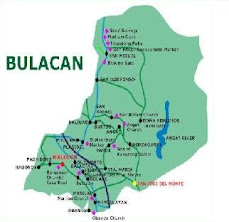This site shall provide you with current updates regarding the development of the Province of Bulacan as of 2010
Thursday, April 15, 2010
Background of the Study
Bulacan is one of the provinces in the Republic of the Philippines located in the Central Luzon Region. It is found in the north of manila, around Bulacan provinces like Pampanga (west), Nueva Ecija (north), Auroa and Quezon (east), and Rizal (south) can be found. The province itself can also be found on the shores of Manila bay. Today, the province of Bulacan is one of the most popular provinces of the country, not only because of its rich history, culture, and arts but also because of its people. The people of Bulacan, who is known for being educated, kind and industrious type of people, are called the Bulakeno (Bulakenyo).
Bulacan very attractive because of the fact that many historical sites, old houses and churches, ecological attractions, developed infrastructure, religious attraction, colorful festivals can be found. Aside from these things, many beautiful resorts, hotels and restaurant are established here to give you selfless service. In addition, it is also a place for starting good businesses and investments, where by good governance is implemented throughout the place. Also, the province of Bulacan is a very peaceful and ordered place. It is well known for its rich history. Many of the national heroes and national artists came from this wonderful province. Examples of these national artists and heroes are Marcelo H. Del Pilar (The Great Propagandist), General Gregorio Del Pilar (The Hero of Tirad Pass), Francisco “Baltazar” Balagtas (The Legendary Poet), Nicanor Abelardo (The Musician), and Guillermo Tolentino (The Nationalist Sculptor).
Bulacan was also one of the eight provinces who first fought the Spain Regime. And the province is honored as one of the eight rays of the Philippine national flag. Moreover in the year 1899, the First Constitutional Democracy in Asia happened in the Barasoain Church in the capital city of Bulacan, Malolos City. Furthermore, Bulacan is much known for its wide variety of industries. Examples of these industries are marble and marbleized limestone, jewelry, pyrotechnics, leather, aquaculture, garments, high-value crops, etc.
Being unaware of the given the desirable characteristics of the province, the group still chose Bulacan as the subject of the case study because it was a different compared to the other choices. Also considered was the proximity of Bulacan to most of the group members because it would be easier to conduct field work. At first, the group did not see Bulacan as a progressive province. Unknown to the group are the achievements of the Local Government Unit of Bulacan and how these achievements led to the development of the province. The group thought of Bulacan as merely a province – mountainous and rich in natural resources. It was not clear whether Bulacan was a developed province. Also, the group associated the province with the North Luzon Expressway since the expressway passes through Bulacan. The group did not see beyond what really was Bulacan and thought only of what was heard and seen of the province. With our initial ideas, it was a blur whether Bulacan was really a competitive province.
Out of curiosity as to how Bulacan is in its current state right now, the group decided to further on the case study. It was unknown to the group what makes up Bulacan and so this motivated us to examine the province. This paper introduces readers to the development planning processes of the province of Bulacan and how this has contributed to the overall performance of the province. Whether or not development planning is successful in Bulacan, this paper gives an overview of what really happens inside Bulacan and what has brought the province to its progressive state at present.
Subscribe to:
Post Comments (Atom)

No comments:
Post a Comment